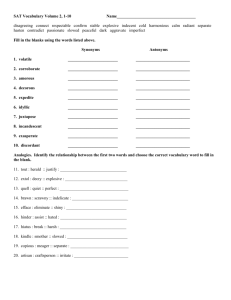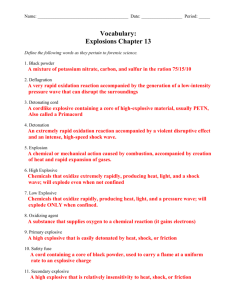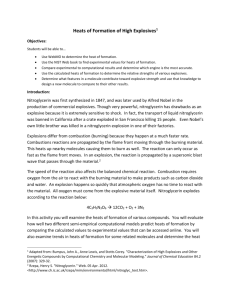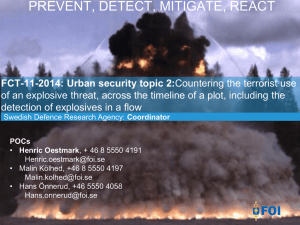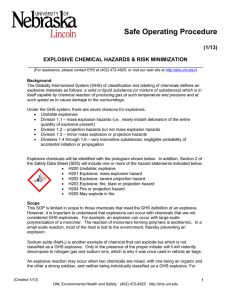DOC
advertisement
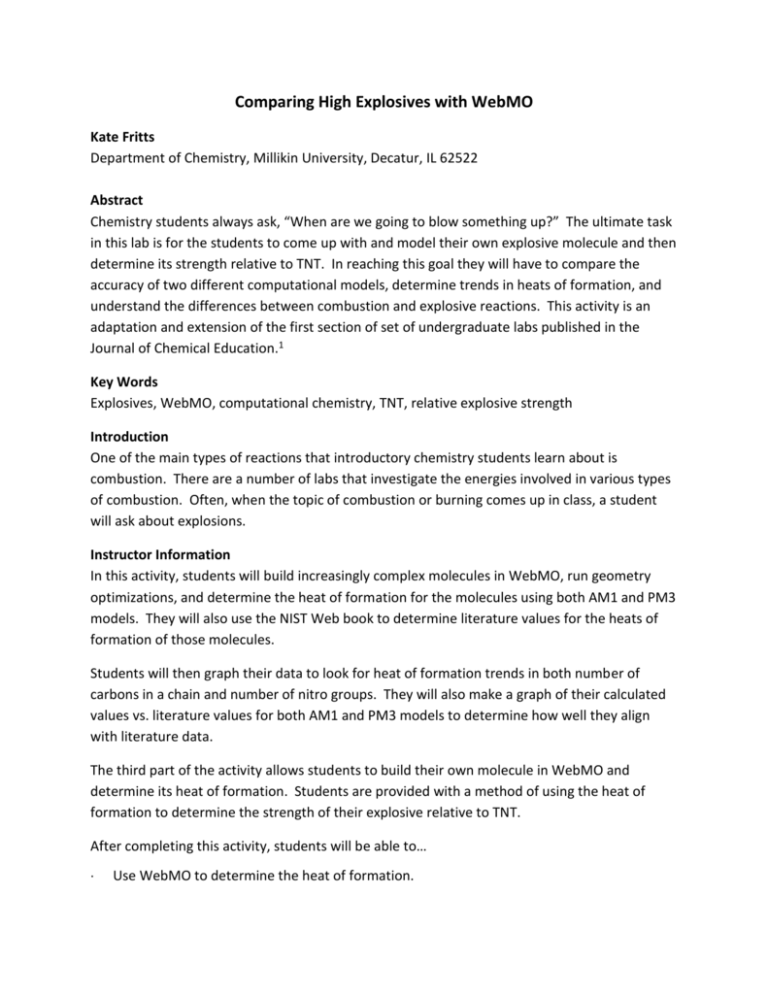
Comparing High Explosives with WebMO Kate Fritts Department of Chemistry, Millikin University, Decatur, IL 62522 Abstract Chemistry students always ask, “When are we going to blow something up?” The ultimate task in this lab is for the students to come up with and model their own explosive molecule and then determine its strength relative to TNT. In reaching this goal they will have to compare the accuracy of two different computational models, determine trends in heats of formation, and understand the differences between combustion and explosive reactions. This activity is an adaptation and extension of the first section of set of undergraduate labs published in the Journal of Chemical Education.1 Key Words Explosives, WebMO, computational chemistry, TNT, relative explosive strength Introduction One of the main types of reactions that introductory chemistry students learn about is combustion. There are a number of labs that investigate the energies involved in various types of combustion. Often, when the topic of combustion or burning comes up in class, a student will ask about explosions. Instructor Information In this activity, students will build increasingly complex molecules in WebMO, run geometry optimizations, and determine the heat of formation for the molecules using both AM1 and PM3 models. They will also use the NIST Web book to determine literature values for the heats of formation of those molecules. Students will then graph their data to look for heat of formation trends in both number of carbons in a chain and number of nitro groups. They will also make a graph of their calculated values vs. literature values for both AM1 and PM3 models to determine how well they align with literature data. The third part of the activity allows students to build their own molecule in WebMO and determine its heat of formation. Students are provided with a method of using the heat of formation to determine the strength of their explosive relative to TNT. After completing this activity, students will be able to… Use WebMO to determine the heat of formation. Use the NIST Web book to find experimental values for heats of formation. Compare experimental to computational results and determine which engine is the most accurate. Use the calculated heats of formation to determine the relative strengths of various explosives. Determine what features in a molecule contribute toward explosive strength and use that knowledge to design a new molecule to compare to their other results. The goals of this activity fall into two categories. The first set of goals focus on getting students to use and evaluate computational models. They are asked to compare the results of two different models to literature data. The second set of goals focus on getting students to think about how the structure of a molecule affects its properties. In this instance, they are looking at what features of a molecule contribute toward heat of formation and relative effectiveness as an explosive. Next Gen standards PS1.A (Structure and Properties of Matter), PS1.B (Chemical Reactions), and PS3 (Energy) are all relevant to this activity. It also incorporates the Next Gen practices of analyzing and interpreting data and using mathematics and computational thinking. Background Explosions differ from combustion because they happen at a much faster rate. Combustions reactions are propagated by the flame front moving through the burning material. This heats up nearby molecules causing them to burn as well. The reaction can only occur as fast as the flame front moves. In an explosion, the reaction is propagated by a supersonic blast wave that passes through the material.2 The strength of an explosive, relative to TNT, can be determined by calculating the heat of explosion from the heats of formation of the possible explosive molecule and the products of its explosion. The products of an explosion differ from combustion because the materials are not interacting significantly with atmospheric oxygen. All of the oxygen in the products must come from the molecule itself. The balanced reaction for the explosion of TNT shows that it does not have sufficient oxygen to fully oxidize the carbon and hydrogen in the molecule. 2 C7H5N3O6 12CO + 5H2 + 3N2 +2C The Kistiakowsky–Wilson rules for determining the products of an explosion prioritize the production of carbon monoxide, water, and then carbon dioxide. In general, more explosive power is generated by molecules that have sufficient oxygen to fully oxidize all carbons to carbon dioxide and all hydrogen to water.3 About the Activity A small class of physical chemistry students was asked to complete this activity. They were able to do all of the calculations and come up with reasonable values. However, a few issues arose that led to some small revisions. In the original version, students were allowed to test any molecule they chose under the assumption that they would try to come up with the best explosive possible based on what they had determined in the first two parts of the lab. While most students did just that (Figure 1), a few made uninspired choices (most notably, dodecane). Most of the students chose to make molecules that are structurally similar to TNT. The student who chose the hydrazine derivative is working with that compound on an undergraduate research project. Figure 1: Student generated explosive compounds O OH O - O + N + N N O O N O R - HN + + N O N N N - O OH phenazine-5,10-dicarboxylic acid O + N O O O 1,2,4,5-tetranitrobenzene N N NH O 2N - O R NO 2 O 2N hydrazine derivative + N O - NO 2 O 2N 1,2-dinitrobenzene O NO 2 + O - N hexanitroethane O + + N dodecane O O N NH2 O - 2,4,6-trinitroaniline The student who chose to test 1,2-dinitrobenzene took the assignment a step farther and examined the ortho-, meta-, and para-isomers. He found the ortho- arrangement of nitro groups to give the largest heat of formation (and thus largest relative strength). Another issue that arose was confusion regarding the relationship of heat of formation to explosive strength. We associate large negative values of heat of formation with stability. While a greater heat of formation indicates less stability and likely a higher relative explosive strength, it is not the sole determining factor of explosive strength. To address those issues, the questions were revised to have the students analyze the expression for relative strength and determine what factors (greater heat of formation, greater moles of gas produced, and lower molecular weight) lead to a greater strength. They are referred back to this analysis when they choose their own molecule to analyze and then asked to justify their choice in light of those factors. It was also decided to add information about oxygen balance to the instructions and to ask students to calculate the oxygen balance for their compound. The calculation is a simple analysis of the chemical formula and will hopefully lead students to choosing better molecules to test. Integration into the Curriculum There are several places in the curriculum where this activity could be used. It could fit into a discussion of combustion reactions and the difference between explosion and combustion. The equations used to calculate heat of explosion are very similar to Hess’s law. Using this activity in a unit with Hess’s law would give an opportunity for an interesting discussion of how engineers and scientists use the same information in different ways. The level of difficulty makes this activity more appropriate for higher level high school or an undergraduate level chemistry course. References 1. Bumpus, John A., Anne Lewis, and Stotts Corey. "Characterization of High Explosives and Other Energetic Compounds by Computational Chemistry and Molecular Modeling." Journal of Chemical Education 84.2 (2007): 329-32. 2. Rzepa, Henry S. "Nitroglycerin." Web. 05 Apr. 2012. <http://www.ch.ic.ac.uk/rzepa/mim/environmental/html/nitroglyc_text.htm>. 3. Ten Hoor, Marten J. "The Relative Explosive Power of Some Explosives." Journal of Chemical Education 80.12 (2003): 1397.
